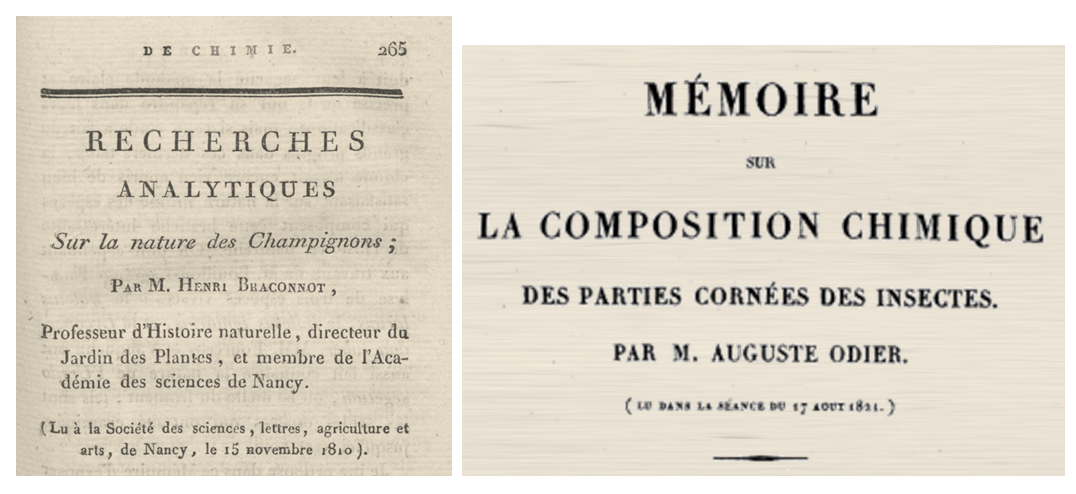https://glycopedia.eu/wp-content/uploads/2019/09/from_chitin_to_chitosan-2-c08.pdf
Henri Braconnot, who was the director of the Botanical Gardens at the Academy of Sciences in Nancy, France, discovered chitin in 1811 after the report of a “material particularly resistant to usual chemicals” by A. Hachett, an English scientist in 1799. The substance, named “fungine,” was extracted from mushrooms that would not dissolve in sulphuric acid and that contained a substantial fraction of nitrogen. Incidentally, that discovery stemmed for investigations on the composition of edible mushrooms and their nutritional value.Braconnot, 1813 In 1823. Antoine Odier published an article on the cuticle of insects, in which he noted that similar substance was present in the structure of insects as was in the structures of fungi.Odier, 1823 He gave the name of the alkaline-insoluble fraction as chitin, from the Greek word, meaning “tunic” or “envelope.” The concept was further known in 1843 when Jean Louis Lassaigne while working of the exoskeleton of silkworm butterfly Bombix morii, demonstrated the presence of nitrogen in chitin.Lassaigne, 1843a,b,c The same year, Anselm Payen, who had reported the identification of cellulose in 1838, initiated interrogation as regard to the difference between cellulose and chitin. Payen, 1843 In 1876, Leddorhose identified glucosamine and acetic acid as structural units of chitin. Ledderhose, 1876 Glucosamine, as the repeated unit of Chitin, was confirmed by Gilson in 1894. However, it took 50 years before Earl R. Purchase, and Charles E. Braun elucidated the final chemical nature of chitinPurchase & Braun, 1946.

The history of chitosan dates back to 1859 when French physiologist Charles Rouget described the deacetylation of chitin through its boiling in the presence of concentrated potassium hydroxide Rouget, 1859Immediately, he recognized that the newly obtained product was soluble in acidic solutions, contrasting with the water-insoluble nature of native chitin, thus opening new possibilities for its use. However, it was not until 35 years later that the modified chitin received the name “chitosan,” as given by the German physiologist and chemist Felix Hoppe-Seyler.Hoppe-Seyler, 1894.
By the early 20th century, a great deal of research had been accomplished on the subject of chitin and chitosan. In 1930, G. Rammelberg’s researches headed to the verification on the uniqueness of chitosan from the sources of chitin, specifically crab shells and fungi, and the production of fibers from these different systems. Later on, came the elucidation of glucosamine, as the monosaccharide constituent of chitin. In the 1950’s x-ray analysis, along with infrared spectroscopy, and enzymatic analysis advanced the study of chitin and chitosan in fungi. The first monograph on chitin and chitosan appeared in 1951.
In the 20th century, scientists began to investigate the polymer’s potential uses and discovered a lot of beneficial properties. Chitin is non-toxic and biodegradable, and therefore more environmentally friendly than most synthetic polymers. It is also an anti-microbial, providing the fungi and animals it coats with anti-disease defenses.
In the early 1960s, the studies on chitosan dealt for its ability to bind with the red blood cells. The substance was considered a hemostatic agent. For three decades now, chitosan has been used at water purification plants for detoxifying water. It spreads over the surface of the water, where it absorbs grease, oils, and other potential toxins. For a while, chitosan was sold over the counter as a “fat blocker” or “fat trapper”. The claim was that chitosan taken as a supplement might reduce the amount of fat absorbed in the gastrointestinal tract. Such a claim has not be substantiated by any reliable scientific evidence.
An essay entitled “Historical landmarks in the discovery of chitin” describes the 220 years of the development of chitin.Crini, 2019 The essay covers five periods : (i) discovery from 1799 to 1894, (ii) a period of confusion and controversy from 1894 to 1930, (iii) exploration in 1930–1950, (iv) a period of doubt from 1950 to 1970, (v) the period of application, from 1970 to the present day.
The present chapter collates the developments and conclusions of many of the extensive studies that have been conducted on chitin and chitosan. We aim to provide a comprehensive presentation of the scientific and technological advances that populate the vast panorama of chitin and chitosan.
